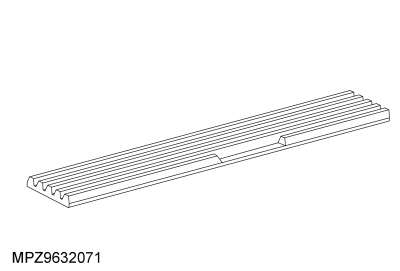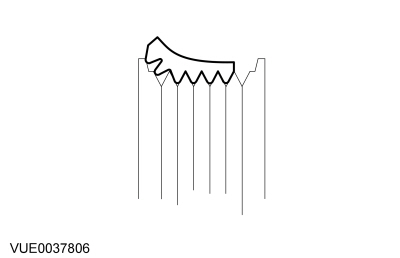Ford Fiesta: Accessory Drive - 1.6L EcoBoost (132kW/180PS) – Sigma / Accessory Drive. Diagnosis and Testing
Inspection and Verification
-
Verify the customer concern.
-
Visually inspect for obvious signs of mechanical damage.
Visual Inspection Chart
| Mechanical |
|---|
|
-
If an obvious cause for an observed or reported concern is
found, correct the cause (if possible) before proceeding to the next
step.
Accessory Drive Belt Concerns
NOTICE: Do not lubricate the accessory drive belt as potential damage to the accessory drive belt material construction may occur.
Cracking
Accessory drive belts are made from rubber which hardens with time and can develop cracks. As the accessory drive belt runs on the back of some of the pulleys, the cracks are opened up. Small cracks are not considered to be a failure of the accessory drive belt. Only if the crack is deep enough to reach the bottom of the groove to expose the cord or any chunks are found to be missing from the accessory drive belt, is the accessory drive belt condition considered to be unacceptable.
-
Check the accessory drive belt for cracks. If the damage
exceeds the acceptable limit, install a new accessory drive belt.
REFER to: Accessory Drive Belt (303-05B Accessory Drive - 1.6L EcoBoost (132kW/180PS) – Sigma, Removal and Installation).
Chunking
Chunking describes the condition where long lengths of rubber become detached from the ribs of the accessory drive belt. This is considered to be a failure of the accessory drive belt.

-
Check the accessory drive belt for damage. If any chunks are
found to be missing, install a new accessory drive belt.
REFER to: Accessory Drive Belt (303-05B Accessory Drive - 1.6L EcoBoost (132kW/180PS) – Sigma, Removal and Installation).
Pilling
Pilling is dust that forms in between the ribs of the accessory drive belt from rubber that is worn off the accessory drive belt when it is new. There may also be loose particles left on the accessory drive belt during the manufacturing process. These are worn off and form into small balls of rubber that then get trapped in the grooves of the accessory drive belt. This condition will usually clear itself within 4800 km - 8000 km (3000 miles - 5000 miles) of normal driving.

-
Check the accessory drive belt for pilling. The condition of
the accessory drive belt should be compared against the illustration.
-
Small scattered pills. Not considered a concern. No action required.
-
Small scattered pills. Not considered a concern. No action required.
-
Longer pills up to 50% of the rib height. Possible noise
concern. INSTALL a new accessory drive belt if noise is apparent.
REFER to: Accessory Drive Belt (303-05B Accessory Drive - 1.6L EcoBoost (132kW/180PS) – Sigma, Removal and Installation).
-
Longer pills up to 50% of the rib height. Possible noise
concern. INSTALL a new accessory drive belt if noise is apparent.
REFER to: Accessory Drive Belt (303-05B Accessory Drive - 1.6L EcoBoost (132kW/180PS) – Sigma, Removal and Installation).
-
Heavy deposits in the grooves. Possible noise and stability concern. INSTALL a new accessory drive belt.
REFER to: Accessory Drive Belt (303-05B Accessory Drive - 1.6L EcoBoost (132kW/180PS) – Sigma, Removal and Installation).
-
Heavy deposits in the grooves. Possible noise and stability concern. INSTALL a new accessory drive belt.
REFER to: Accessory Drive Belt (303-05B Accessory Drive - 1.6L EcoBoost (132kW/180PS) – Sigma, Removal and Installation).
-
Small scattered pills. Not considered a concern. No action required.
Incorrect fitment
Accessory drive belt noise can be generated by the accessory drive belt being incorrectly fitted on the pulley as shown in the following illustration. Make sure that all the V grooves on the accessory drive belt contact correctly with the pulley.

-
If the cause is not visually evident, verify the symptom and refer to the Symptom Chart.
Symptom Chart
| Symptom | Possible Sources | Action |
|---|---|---|
|
|
|
|
|
|
|
|
|
|
|
|
|
|
|
|
|
|
 Accessory Drive Belt. Removal and Installation
Accessory Drive Belt. Removal and Installation
Special Tool(s) /
General Equipment
Trolley Jack
Wooden Block
Removal
NOTE:
Removal steps in this procedure may contain installation details...
Other information:
Ford Fiesta 2014 - 2019 Service Manual: Information and Entertainment System - System Operation and Component Description. Description and Operation
System Operation System Diagram Network Message Chart A missing network message is indicated by a U-code DTC and can be the result of intermittent concerns such as damaged wiring or low battery voltage occurrences. Additionally, vehicle repair procedures such as module reprogramming can set these Diagnostic Trouble Codes (DTCs)...
Ford Fiesta 2014 - 2019 Service Manual: Charge Air Cooler (CAC). Removal and Installation
Removal NOTE: Removal steps in this procedure may contain installation details. Remove the front bumper cover. Refer to: Front Bumper Cover (501-19 Bumpers, Removal and Installation). Remove the retainers and the lower air deflector...
Categories
- Manuals Home
- Ford Fiesta Service Manual (2014 - 2019)
- Maintenance Schedules
- General Information
- Climate Control System - General Information
- Service Information
- Engine
Wheels and Tires. Diagnosis and Testing
Preliminary Inspection
Verify the customer concern by carrying out a road test on a smooth road. If any vibrations are apparent, Refer to the Symptom Chart: NVH.To maximize tire performance, inspect for signs of incorrect inflation and uneven wear, which may indicate a need for balancing, rotation or front suspension alignment.
Correct tire pressure and driving techniques have an important influence on tire life. Heavy cornering, excessively rapid acceleration and unnecessary sharp braking increase tire wear.
Correct tire pressure and driving techniques have an important influence on tire life. Heavy cornering, exce

